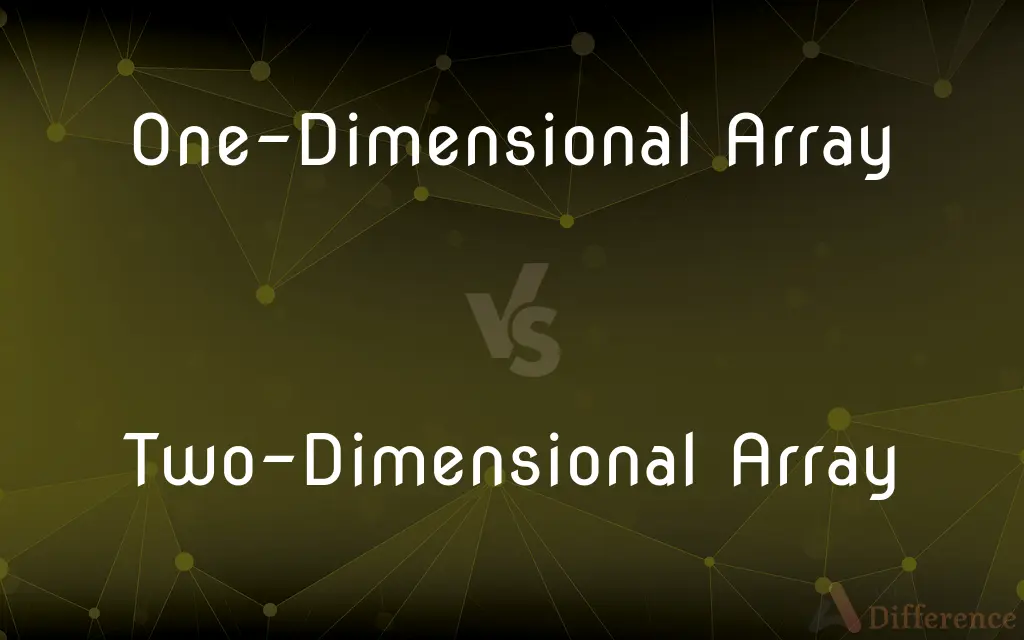One-Dimensional Array vs. Two-Dimensional Array — What's the Difference?
By Tayyaba Rehman & Urooj Arif — Published on January 31, 2024
A one-dimensional array is a list of elements in a single row, whereas a two-dimensional array is a collection of elements in rows and columns, resembling a matrix.

Difference Between One-Dimensional Array and Two-Dimensional Array
Table of Contents
ADVERTISEMENT
Key Differences
One-Dimensional Array is a linear data structure consisting of a collection of elements in a single row, with each element accessed through its index. It is akin to a list where elements are stored sequentially. Two-Dimensional Array, in contrast, is like a table consisting of rows and columns. Each element is accessed through two indices, representing its row and column, making it similar to a matrix in mathematics.
One-Dimensional Array is simple to implement and manage, as it requires only one loop for traversal or manipulation. It's well-suited for storing simple sequences of data. Two-Dimensional Array requires nested loops for traversal or manipulation, making it slightly more complex. It is ideal for storing more complex data structures like matrices, grids, or tables.
In memory, a One-Dimensional Array occupies a contiguous block where elements are stored in a linear order. This makes access and iteration over the elements efficient. Two-Dimensional Array, however, can be stored in memory either as a single linear block with row-major or column-major order or as an array of arrays, affecting its memory layout and access patterns.
One-Dimensional Array is typically used in scenarios where a simple list or sequence of elements is required, like storing a series of values or characters. Two-Dimensional Array finds its use in more complex applications like representing a chessboard in a game, spreadsheets, or in algorithms involving matrices.
The complexity of operations such as searching, insertion, and deletion in a One-Dimensional Array is generally lower due to its linear nature. In a Two-Dimensional Array, these operations can be more complex and time-consuming, especially if the array size is large, due to the additional dimension involved.
ADVERTISEMENT
Comparison Chart
Structure
Collection of elements in a single row
Collection of elements in rows and columns
Indexing
Accessed with a single index
Accessed with two indices (row and column)
Implementation Complexity
Simple, with single loop for traversal
More complex, requires nested loops
Memory Layout
Linear, contiguous memory block
Row-major or column-major order, or array of arrays
Use Cases
Suitable for simple lists or sequences
Ideal for matrices, grids, tables
Compare with Definitions
One-Dimensional Array
One-dimensional array is suitable for simple data storage.
We used a one-dimensional array for storing the product codes.
Two-Dimensional Array
A two-dimensional array can store a table of elements.
The student grades were organized in a two-dimensional array.
One-Dimensional Array
One-dimensional arrays are accessed by a single index.
We accessed the fifth element in the one-dimensional array using its index.
Two-Dimensional Array
Two-dimensional array allows for complex data representations.
We created a two-dimensional array to represent a pixel grid for an image.
One-Dimensional Array
A one-dimensional array is a linear sequence of elements.
We stored the temperatures of the week in a one-dimensional array.
Two-Dimensional Array
A two-dimensional array is a matrix-like structure with rows and columns.
The chessboard was represented as a two-dimensional array.
One-Dimensional Array
One-dimensional array represents a list of items in a single row.
The one-dimensional array contained all the student names.
Two-Dimensional Array
Two-dimensional arrays are accessed by row and column indices.
We retrieved data from the two-dimensional array using row and column numbers.
One-Dimensional Array
A one-dimensional array holds elements of the same data type.
Our one-dimensional array had integers representing ages.
Two-Dimensional Array
Two-dimensional arrays are ideal for multidimensional data.
The geographic map was stored as data in a two-dimensional array.
Common Curiosities
How are elements in a two-dimensional array accessed?
Elements in a two-dimensional array are accessed using two indices: row and column.
How is data accessed in a one-dimensional array?
Data in a one-dimensional array is accessed using a single index.
Is a two-dimensional array more complex than a one-dimensional array?
Yes, a two-dimensional array is more complex due to its matrix-like structure.
Can you store a matrix in a one-dimensional array?
A matrix is best represented in a two-dimensional array, not a one-dimensional array.
What are typical uses of a one-dimensional array?
One-dimensional arrays are used for simple lists or sequences of data.
What is a one-dimensional array?
A one-dimensional array is a linear sequence of elements, like a list.
How is memory allocated for a two-dimensional array?
Memory for a two-dimensional array can be allocated in row-major or column-major order, or as an array of arrays.
Are operations in a one-dimensional array simpler than in a two-dimensional array?
Yes, operations like searching and sorting are generally simpler in a one-dimensional array.
Can a one-dimensional array store different data types?
Usually, a one-dimensional array stores elements of the same data type.
How is memory allocated for a one-dimensional array?
Memory for a one-dimensional array is allocated in a contiguous linear block.
Can a two-dimensional array be visualized as an array of arrays?
Yes, a two-dimensional array can be thought of as an array of one-dimensional arrays.
Is it possible to convert a two-dimensional array into a one-dimensional array?
Yes, a two-dimensional array can be flattened into a one-dimensional array.
What is a two-dimensional array?
A two-dimensional array is a collection of elements in a table form with rows and columns.
What are typical uses of a two-dimensional array?
Two-dimensional arrays are used for matrices, grids, and table-like data structures.
How do you traverse a two-dimensional array?
Traversing a two-dimensional array usually requires nested loops, one for rows and one for columns.
Share Your Discovery

Previous Comparison
Fexofenadine vs. Cetirizine
Next Comparison
Ref in C# vs. Out in C#Author Spotlight
Written by
Tayyaba RehmanTayyaba Rehman is a distinguished writer, currently serving as a primary contributor to askdifference.com. As a researcher in semantics and etymology, Tayyaba's passion for the complexity of languages and their distinctions has found a perfect home on the platform. Tayyaba delves into the intricacies of language, distinguishing between commonly confused words and phrases, thereby providing clarity for readers worldwide.
Co-written by
Urooj ArifUrooj is a skilled content writer at Ask Difference, known for her exceptional ability to simplify complex topics into engaging and informative content. With a passion for research and a flair for clear, concise writing, she consistently delivers articles that resonate with our diverse audience.
















































